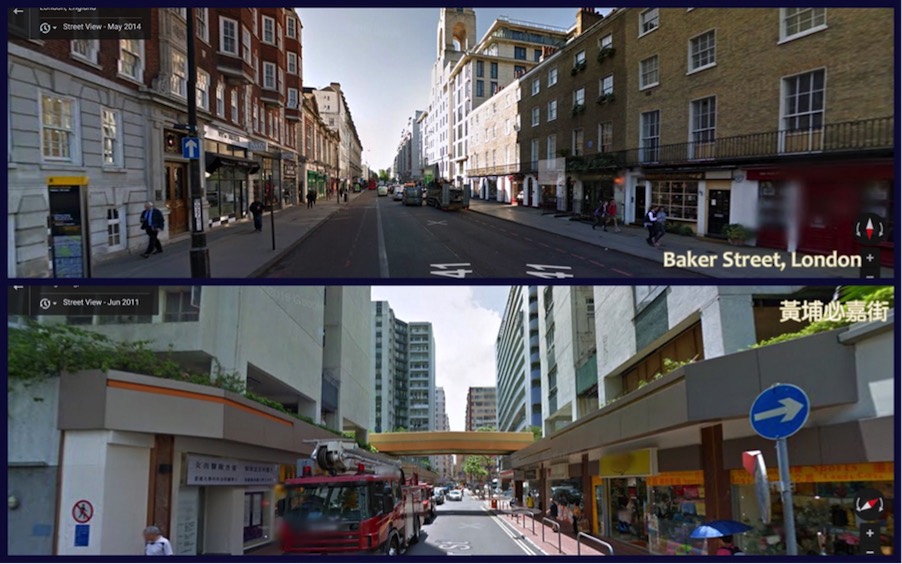Hong Kong’s street names are one of more visible legacies from the colonial era. Whether they are derived from public figures or geographical landmarks, the kaleidoscopic collection has offered us a unique insight into the east-meets-west blending of cultures in the city.
Much of the names have remained unchanged in the post-handover world, allowing us to preserve the city’s heritage in its entirely. This is true even for the most undesirable namesakes. Take Elgin Street (伊利近街) in Central for example: it honours James Bruce, the eighth Earl of Elgin, who is responsible for the order to loot and destroy the Summer Palace in Beijing.
The thought of this post came me while I was walking down Gloucester Road, West London. I was going to the underground station when it occurred to me that Hong Kong also has a Gloucester Road (告士打道) in Causeway Bay, but that eight-lane highway is nothing like the rather upmarket shopping street that I traversed. So I started doing some research: how many of Hong Kong’s main roads have a British counterpart and vice-versa? Beyond their common names, do they share any other similarities?
Given the general lack of imaginative naming in the British tradition (Exhibit: Doesn’t this new land look like South Wales? Let’s call it New South Wales!), it is hardly surprising that a great many Hong Kong streets have British namesakes. Some of these share the same etymology, while some others’ similarities are sheer coincidence.
#1: Queen Victoria Street / 域多利皇后街 (London EC4/ Central)

Naming locations after the monarchy is probably the fashionable and politically correct thing to do in the years past, and as a result, there are a bunch of King’s and Queen’s Roads everywhere in the UK and the Commonwealth countries. As the monarch who reigned over the British Empire for much of its most dominant decades, Queen Victoria is likely the most popular name British colonial officials used when in need of new inspiration. Wikipedia has a long list of “Victorias” across the globe, and in Hong Kong alone there are roads, the major park in Causeway Bay and the historical capital of the territory named in her honour.
There is a Queen Victoria Street in the heart of Central and the City of London, and their similarities extend beyond the commemoration of the same monarch. Both were built in the mid-19th century as new roads into the commercial heart of town, and have by now become flagship addresses for the financial industry, home to major banks and some interesting landmarks.
I should mention that their names are only identical in English: the Chinese translation has the street as “Queen Consort Victoria Street”. After centuries of imperial rule, the Qing-educated Chinese scribes just couldn’t quite grasp the concept of a female monarch.
#2: Oxford Road / 牛津道 (Manchester M1/ Kowloon Tong)
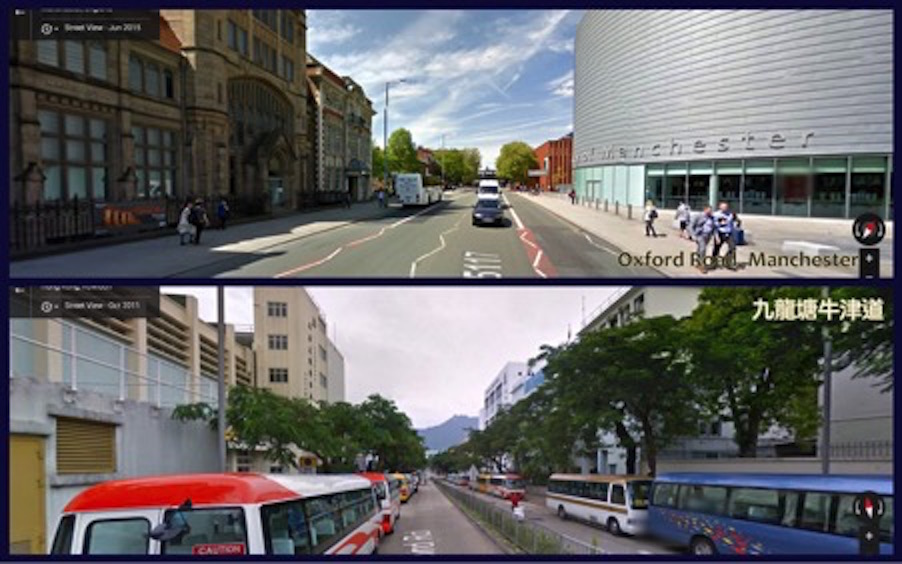
Besides Central, any self-professed geography nerds or those interested in British-themed street names in Hong Kong must add Kowloon Tong on their list of priorities. The streets, which are lined with some of the city’s most exclusive residences, are almost all named after British counties and cities. Famous for its university worldwide, Oxford has naturally made the cut. Nearby streets also include Hampshire Road and Durham Road, although the accolade of the major road went to Cornwall.
While Hong Kong’s Oxford Road is narrowly different in name with London’s premier shopping street (Oxford Street), there are many other Oxford Roads across Britain, usually named because it is the road to, you guessed it, Oxford. Comparing Hong Kong and Manchester’s Oxford Road (a major thoroughfare leading to the south of the city) reveals an uncanny convergence in function: education.
Hong Kong’s Oxford Road may be a backstreet, but at one time it boasted as many as seven primary and secondary schools and is a stone’s throw away from the Baptist University; meanwhile, both of Manchester’s universities are located on Oxford Road. In fact, the road passes through Europe’s largest urban university zone.
So people have been using Oxford Road to go to school across continents. It’s named after Oxford, after all.
#3: Baker Street / 必嘉街 (London NW1/ Hung Hom)
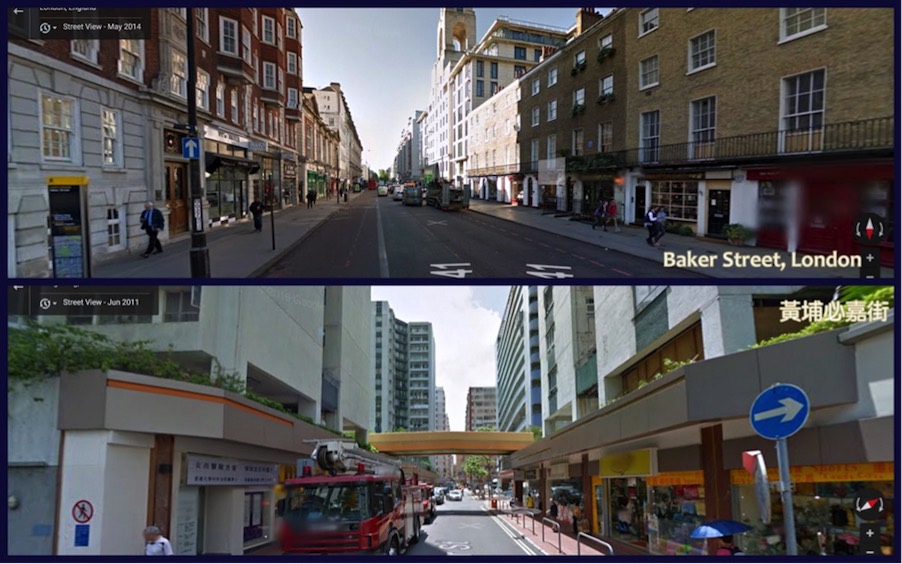
Named after its builder (and disappointingly without any connections to cake), Baker Street in London is world famous for one fictional tenant on a non-existent address: 221B, home to a certain Mr. Sherlock Holmes. When Sir Arthur Conan Doyle first created Sherlock’s address, Baker Street’s numbering did not run into the hundreds. A postal readjustment led to a 1930s block formerly of a bank covering numbers 219 to 229, and from then on letters addressed to 221B would arrive at the bank – so much so, that it employed a full-time Sherlock secretary just to reply to all the fan mail. (The correspondence now goes to the Sherlock Holmes Museum down the road.)
Hong Kong’s Baker Street likewise has no connection with bakeries and instead is named after Robert Baker, the chief engineer of the Kowloon-Canton Railway. Like its London namesake, this Baker Street also does not have a number 221B: the highest is number 121 and part of Whampoa Garden.
With its large tower block developments above everyday shops, Hong Kong’s Baker Street seems an accurate scene for ordinary Hong Kong life, much like how London’s would have been for Sherlock. So I guess if Sherlock ever moved to Hong Kong, he would be stepping out a Whampoa lift into the Hung Hom streets before hailing a red minibus. Somehow I struggle to see Benedict Cumberbatch doing that. Martin Freeman surely would, though.
#4: Amoy Street /廈門街 (Southampton SO15/ Wan Chai)
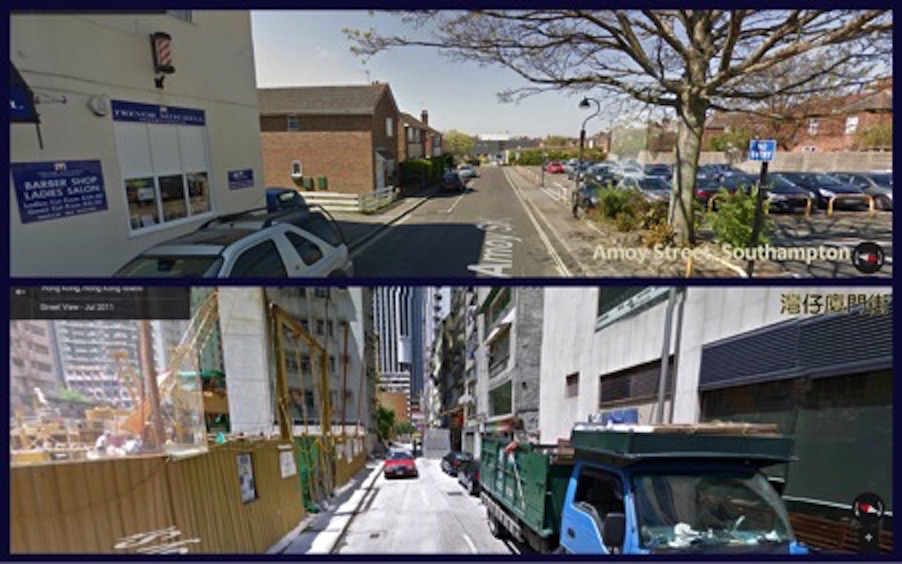
From Canton to Nanking, Hong Kong’s neighbours have often provided inspiration for the city’s town planners for new street names. Chinese cities are popular choices, with their established trade and demographic connections – therefore, a noticeable share of Hong Kong streets bear names of Chinese locales even while under British rule. Naturally, British town planners have taken a similar approach. Although with an entire empire of cities to choose from, predictably Chinese cities are rarely on their minds: neither Beijing nor Shanghai (in any spelling) makes an appearance.
However, two cities are the exception: Amoy, the Hokkien spelling for Xiamen and Canton. An Amoy Street and a Canton Street lie largely unnoticed in the heart of Southampton, the departure port of the Titanic and still a major container port in its own right. It is in no way a prominent boulevard, but rather more akin to a narrow side street leading towards a dead-end carpark. If you search for the street on Google, you’ll find directions to that carpark for cruisers and the closure of a mental clinic in 2012. Pretty dark stuff.
So why has Amoy made the cut in Hong Kong and in Britain when other Chinese cities did not? Besides the common maritime heritage that links the ports from Amoy to Hong Kong to Southampton, there is also a classically British twist: throughout the 19th century, Amoy was the major port of export of tea from China.
You can see why the Sotonians made an exception now, can’t you?
#5: Seven Sisters Road/七姊妹道 (London N4/ North Point)
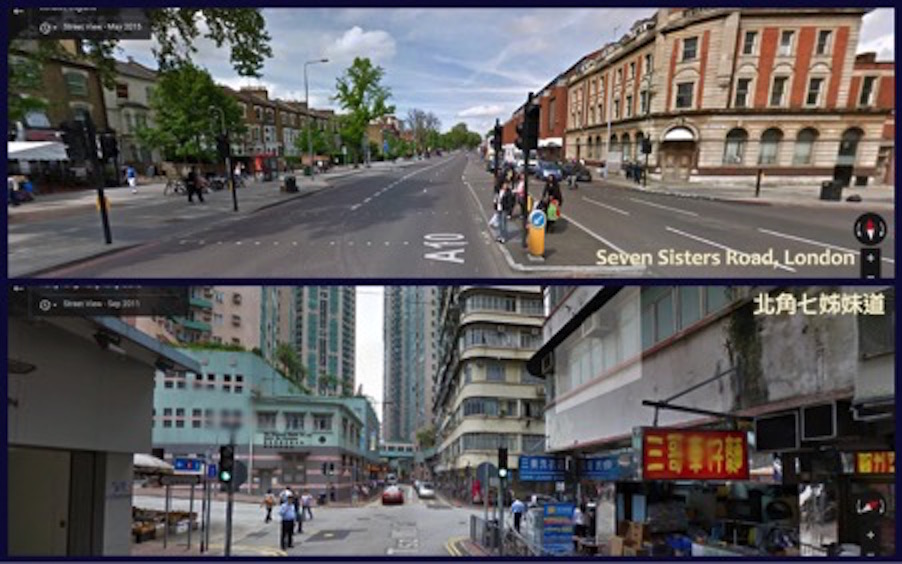
Of all the streets here, this is perhaps my favourite: natural and spontaneous coincidence, without official intervention. There is a Seven Sisters in North London, a name derived from seven trees on the common land.
There is also a Tsat Tsz Mui (literally “Seven Sisters”) in North Point too, with a far more poignant tale according to folklore.
The story goes that seven Hakka girls pledged to be sisters in their lifetime, die on the same day and never get married. When one of the sisters was forced into marriage, they decided to commit suicide together at the seashore. The next day seven rocks appeared by the bay, and from then on the area is known as Tsat Tsz Mui.
Their names may have been derived with completely different origins, but the streets are actually quite similar: they are both often-congested roads serving inner city neighbourhoods. At least, that was the case prior to land reclamation when King’s Road (another common street name, by the way) superseded its functions.
BONUS: Searching for Hong Kong
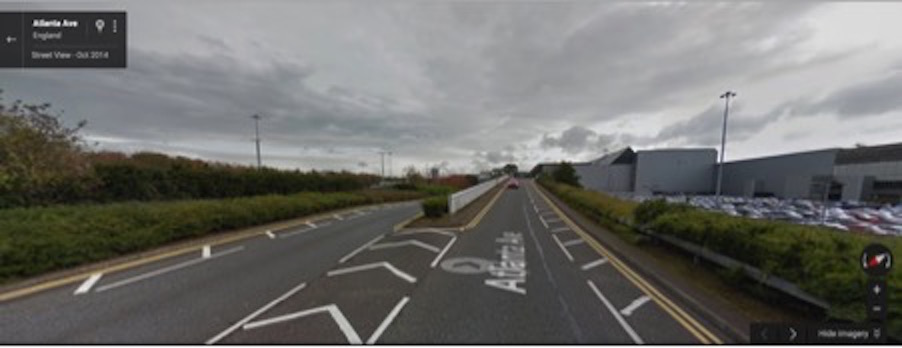
In the spirit of finding out where Hong Kong meets the UK, I discovered that there is a Hong Kong Avenue at an unexpected location: Manchester Airport. Much like in Kai Tak or Chek Lap Kok, the streets around Manchester Airport also take on an aviation theme, in this case major destination – even if direct passenger flights to Hong Kong were only reinstated in 2014.
The good news: Hong Kong is one of two Asian cities chosen. And unlike the side street that is Singapore Avenue, Hong Kong Avenue runs right past the terminal. Local bragging brights secured.
The bad news: by “right past”, it’s more like underneath. It’s a connecting road to the carpark. Oh well!
Check out Justin’s blog and Facebook page.
